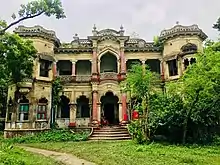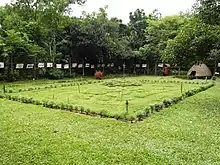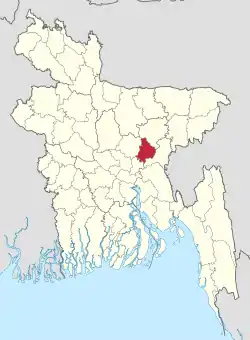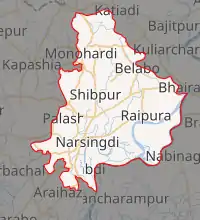Narsingdi District
Narsingdi District (Bengali: নরসিংদী জেলা) is a district in central Bangladesh. It is located 50 km north-east of Dhaka, capital city of Bangladesh. It is a part of the Dhaka Division.[2] The district is famous for its textile craft industry. Narsingdi is bordered by Kishoreganj in the north and north-east, Brahmanbaria in the east and south-east, Comilla in the south and south-east, Narayanganj in the south and south-west and Gazipur in the west.
Narsingdi
নরসিংদী | |
|---|---|
 .jpg.webp)   .jpg.webp) Clockwise from top-left: Parulia Shahi Mosque, Bridge at Narsingdi, Wari-Bateshwar ruins, Swamp in Raipura Upazila, Lakkan Sahar Zamindar bari | |
 Location of Narsingdi District in Bangladesh | |
 Expandable map of Narsingdi District | |
| Coordinates: 23.92°N 90.73°E | |
| Country | |
| Division | Dhaka Division |
| Government | |
| • Deputy Commissioner | Syeda Farhana Kawnine |
| Area | |
| • Total | 1,150.14 km2 (444.07 sq mi) |
| Population (2011)[1] | |
| • Total | 2,224,944 |
| • Density | 1,900/km2 (5,000/sq mi) |
| Time zone | UTC+06:00 (BST) |
| Postal code | 1600 |
| Website | Official website |
Subdivisions
There are six upazilas, or subdivisions, in the Narsingdi district.
Demographics
According to the 2011 Bangladesh census, Narsingdi district had a population was 2,224,944, of which 1,102,943 were males and 1,122,001 females. Rural population was 1,777,299 (79.88%) while the urban population was 447,645 (20.12%). Narsingdi district had a literacy rate of 49.60% for the population 7 years and above: 50.56% for males and 48.86% for females.[1]
Muslims make up 93.00% of the population, while Hindus are 5.65% of the population.[1]
Rivers
The Meghna, the Shitalakshya, the old Brahmaputra, Arial Kha, Haridhoa, and Paharea are some of the main rivers that flow through this district.
Gallery
See also
References
- "Bangladesh Population & Housing Census 2011 (Zila series)". Bangladesh Bureau of Statistics.
- Md. Mosharraf Hossain Sarkar (2012). "Narsingdi District". In Sirajul Islam and Ahmed A. Jamal (ed.). Banglapedia: National Encyclopedia of Bangladesh (Second ed.). Asiatic Society of Bangladesh.
External links
| Wikimedia Commons has media related to Narsingdi District. |
.jpg.webp)
.jpg.webp)
.jpg.webp)
.jpg.webp)
.jpg.webp)